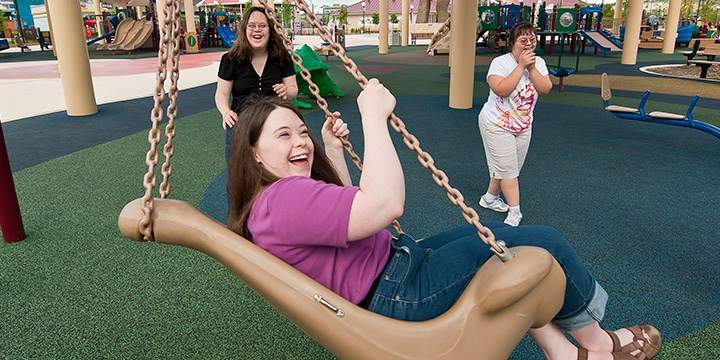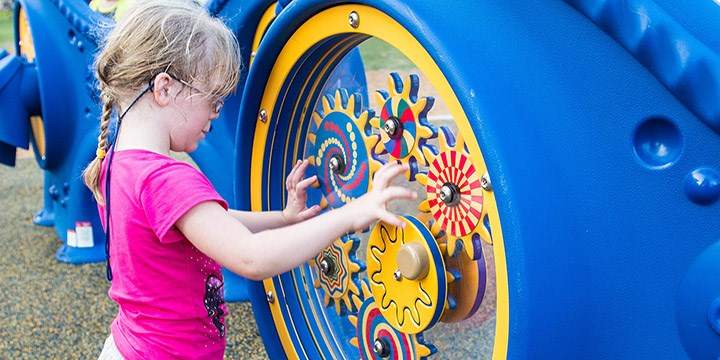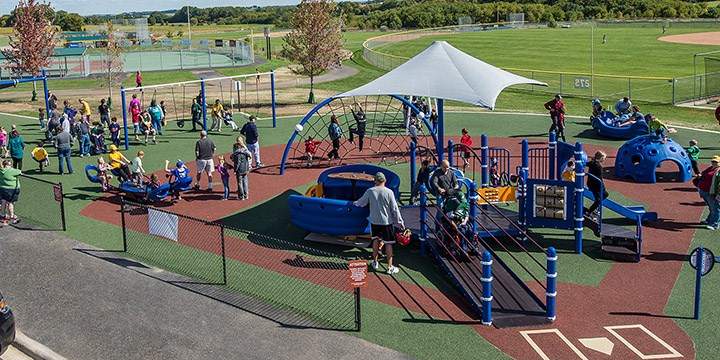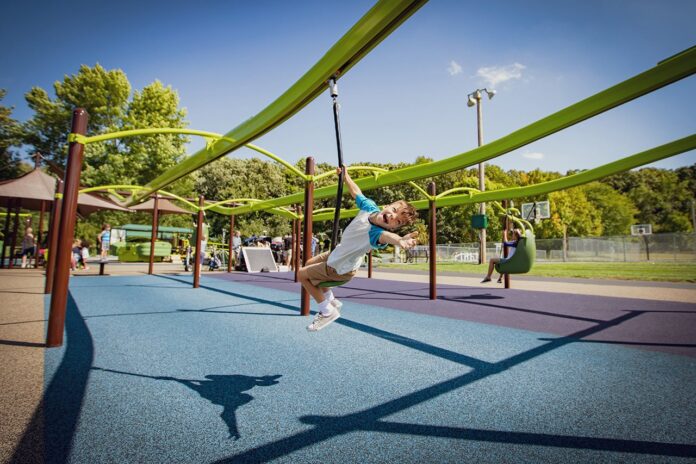What do children learn through play? Play helps children grow and learn — how they move, how their muscles work, their tactile senses, vision and hearing… all develop as they play. And physical learning contributes to cognitive development, as children hone their motor skills and spatial perception.
Swiss child psychologist Jean Piaget famously wrote, “Play is the work of childhood.” Children also learn from interactions with each other, as seen on playgrounds every day.
Playgrounds have evolved over the decades, becoming safer and more varied in design. But children with special needs were somewhat left out of traditional playground design. A movement began to ensure children of all abilities would be able to use playgrounds.
However, initial attempts often fell short. Accessibility, as defined by the 1990 Americans with Disabilities Act (ADA), simply meant being able to get to a playground. Children with physical disabilities, like those needing mobility devices, were unable to experience playgrounds using sand or wood chips for safety surfacing, while the needs of children with sensory processing disorders were often overlooked completely.
One in seven U.S. children live with a disability — about 6.5 million school-aged children — and 6.4 million have cognitive disabilities. According to a recent study by the CDC, one in 45 children has autism.
What do children with varying abilities need in a playground to help them play, learn and grow? The experts advising the playground designers at Landscape Structures Inc. re-imagine playgrounds to be not just inclusive, but inspiring and fun for kids of all abilities.

Physical Environment
Inclusive playgrounds for children with disabilities need to be designed not just for accessibility, but inclusivity.
- Unitary surfacing with one type of material, amenable to wheelchairs and other mobility devices, eliminates mobility barriers.
- Borders or fencing can help define and contain the activity area, providing a sense of comfort to children and their caregivers.
- Seating should be strategically located around the play area (preferably in shaded spaces) and must be usable for children and adults of differing abilities.
- Pathways and ramps must be extra-wide and accessible, for more than one child in a wheelchair to pass each other comfortably.
- On-deck transfer ability delivers equitable access and encourages interactive play among kids and adults of all abilities.
Stimulating Activities
Inclusive playgrounds provide activities to engage children on many levels, in terms of physical, cognitive, sensory and social development.
Play areas reinforcing cognitive concepts with games, mazes, maps, tracing panels and more can be included in playground structures.
Imaginary play, like using pretend houses, fire trucks or stores, allows children to experiment with rules and roles.

Physical play structures invite children of differing abilities to take risks and challenge themselves, creating a sense of mastery and achievement. Thoughtfully designed areas are inclusive for all children. While not all children will be able to use all equipment, children can challenge themselves in ways that they can control and manage.
- Cardiovascular activity: free space for children to move and increase their heart rates.
- Balance and coordination: balance beams, rope bridges and more.
- Vestibular sense: using input from the inner ear, this sense is responsible for equilibrium and movement, experienced while rotating, swinging and rocking.
- Proprioception: this internal sense uses input from muscles and joints about body position, weight, pressure and movement to help develop muscle sense and coordination, affecting large motor skills and small motor activities such as handwriting. Climbing, hanging and overhead activities help children develop this sense, and can be experienced by children using their upper bodies to access equipment.
- Tactile, visual and auditory stimulation: children benefit from calming sensory activities using manipulative media like sand or water, visual stimulation like artwork, plus musical elements to help kids tune in to their auditory sense.
Quiet Spaces
For children who need quiet time and limited social interaction, it is essential to include smaller, cozier spaces where children can experience calm.

Social Activities
Ideal playgrounds are designed for children to interact, with no child feeling excluded, and incorporate a variety of gathering spots within the playground structure — some that can accommodate several children, plus smaller, quiet spaces for just a few. These social spaces benefit everyone, including families and caregivers.
To see inclusive playgrounds and how children use them, visit playlsi.com/inclusive-play/.
[BPT]
Feature photo credit: Brandpoint | Three article photo credits: Landscape Structures






